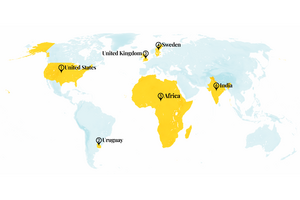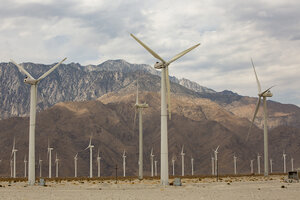Most of the world wants action on climate change. Here’s what’s going right.

The U.S. is adding a record amount of clean energy capacity
Developers built 20.2 gigawatts of electricity generation capacity in the first half of 2024, up 21% from the same period last year.
Solar led the way at 59% of new additions, followed by battery storage at 21%, wind at 12%, nuclear at 5%, and fossil gas at 2%.
Developers were scheduled to double the pace in the second half of 2024. The total added capacity is about what’s needed to offset a 1% carbon emissions increase from the power sector this year.
Sources: Canary Media, U.S. Energy Information Administration
Why We Wrote This
As delegates at COP29 express both urgency and optimism, our progress roundup takes a look at what’s been accomplished around the world to fight climate change so far.
Uruguay is generating electricity using more than 90% renewable energy
Without fossil fuel reserves of its own, Uruguay relied on hydropower until droughts in the early 2000s forced the government to begin importing more oil. After political consensus was achieved in 2008 for a comprehensive new plan, Uruguay’s transition took less than a decade.
Wind has grown to make up 40% of the energy mix, while solar produces 4% and represents the most potential for growth. The transition has created 50,000 jobs, or 3% of Uruguay’s labor force.
Sources: Earth.org, World Resources Institute, Energy and Climate Partnership of the Americas, NPR
Britain became the first major economy to stop using coal for electricity
The backbone of the Industrial Revolution, coal powered the U.K. for 142 years. The last coal-fired plant, the Ratcliffe-on-Soar Power Station, closed Sept. 30.
Half a century ago, close to 90% of the U.K.’s electricity came from coal – known as the dirtiest fossil fuel. Britain is the largest nation to phase out coal by relying heavily on wind and solar, which supply over half of its electricity. Coal is still used for steel manufacturing.
Sources: CNN, ClientEarth
Sweden has cut emissions by 80% since 1990 while growing its economy
European Union countries reduced greenhouse gases by an average of 30% in that time frame.
Sweden implemented one of the world’s first carbon taxes, which lowered transport emissions by a yearly average of 6%. The Nordic country was also an early adopter of district heating, which is expensive but replaces less efficient individual heating systems. Sweden’s energy mix includes biofuels and waste, nuclear, oil, and hydropower.
Widespread public support and close government-private cooperation are credited for enabling Sweden’s environmental leadership.
Source: Deutsche Welle
Climate tech funding has grown across Africa
Overall investment is still a fraction of what analysts say is needed for the continent to meet climate goals. But climate tech startups raised 9% more in 2023 than in 2022, tripling their fundraising from 2019, according to the funding database Africa: The Big Deal.
These companies now make up 43% of the venture funding raised by African startups, up from less than 10% in 2021. They offer services ranging from solar-powered pumps for irrigation to off-grid solar power; three-quarters of the funding supports energy and water needs.
Sources: The Economist, The Associated Press
India installed 280% more solar in the first half of 2024 than in the same period last year
The world’s most populous country is now the third-largest generator of solar power, behind China and the United States. Solar energy makes up one-fifth of India’s power capacity, and 87% is utility-scale, which feeds the grid.
Solar is the fastest-growing energy source, thanks to increasing affordability. The world nearly doubled its solar capacity in 2023 from 2022 and is on track to grow 29% in 2024. In 2023 alone, China installed more solar panels than any other country has in total.
Sources: Vox, PV Magazine, Ember
The majority of the world cares about climate change
Research shows people underestimate support for climate action. Yet one survey of 130,000 people across 125 countries found that 89% want to see more political action addressing climate change, and 69% would be willing to pay 1% of their income to fight climate change.
Another study in 63 countries found that 86% of respondents believe in climate change, and over 70% support climate change policies.
Researchers say governments, businesses, and individuals are more likely to back policy changes if they are aware that others are also in favor.
Source: Our World in Data


